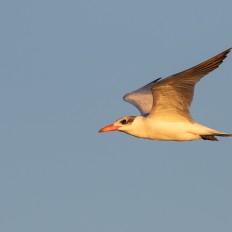Spring:
Though not as diverse as fall, spring is also a fairly productive time of year. Early March through earl April evenings will treat you to a display of 20-30 American Woodcocks. Starting as early as late March, breeders such as Brown Thrasher, White-eyed Vireo, Eastern Meadowlark, Field Sparrow, Song Sparrow, and Prairie Warbler begin to sing and establish territory's. A little later sometime in the last week of April most other breeders including Yellow-breasted Chats, various species of warblers, Indigo Buntings, Orchard Orioles, Wood Thrushes and Gray Catbirds arrive filling the air with all sorts of songs. On occasion a few Henslow's sparrows attempt to breed. By late may most birds have stopped singing though you do have a good chance of hearing Black-billed Cuckoo during this time period.
Summer:
Throughout the summer a number of uncommon species breed throughout the WMA. Most sought after being Yellow-breasted Chat, Prairie Warbler, and Blue-winged Warbler. Throughout June and July you'll still hear the songs of Red-eyed Vireos, Blue-winged Warblers, Indigo Buntings and the occasional Yellow-breasted Chat. By late July the slow trickle of failed breeders and early migrants begins. One or two Tennessee Warblers usually show up by the first week of August and by the second week species such as Yellow Warbler and American Redstart to start to show up in decent numbers. By now fall has begun in the birding world.
Fall:
By far the most productive time of year at Little Indian Creek. By August 15th days with 10 species of warblers are not uncommon here. Early arrivals of neotropic songbirds begin to pick up by the third week of August and days with 50+ species happen regularly with the right observer. Olive-sided Flycatchers have a small peak during this migration period and by the last of August nearly every species of warbler will have started to show up in some density. September is the peak time at Little Indian Creek with 60 species days happening very often. The first week of September shows the continuation of neotropic migrants arriving in higher density, and the tail end of early migrants such as Yellow Warbler and Louisiana Waterthrush. Sometime by the second week of September, the first Connecticut Warblers show, their presence lasts till the end of September. These birds require some searching to find but usually in the first row of small trees on the right along the straight trail is the best place to find them. By the last week of September neotropic species density drops off and the sparrows and Yellow-rumped Warblers become the star of the show. People have had such rarities such as Lark Sparrow during this time period so it's always good to check large sparrow flocks when birding in October. This time of year is also hunting season so make sure you wear orange and stay on the trail.
Spring:
Though not as diverse as fall, spring is also a fairly productive time of year. Early March through earl April evenings will treat you to a display of 20-30 American Woodcocks. Starting as early as late March, breeders such as Brown Thrasher, White-eyed Vireo, Eastern Meadowlark, Field Sparrow, Song Sparrow, and Prairie Warbler begin to sing and establish territory's. A little later sometime in the last week of April most other breeders including Yellow-breasted Chats, various species of warblers, Indigo Buntings, Orchard Orioles, Wood Thrushes and Gray Catbirds arrive filling the air with all sorts of songs. On occasion a few Henslow's sparrows attempt to breed. By late may most birds have stopped singing though you do have a good chance of hearing Black-billed Cuckoo during this time period.
Summer:
Throughout the summer a number of uncommon species breed throughout the WMA. Most sought after being Yellow-breasted Chat, Prairie Warbler, and Blue-winged Warbler. Throughout June and July you'll still hear the songs of Red-eyed Vireos, Blue-winged Warblers, Indigo Buntings and the occasional Yellow-breasted Chat. By late July the slow trickle of failed breeders and early migrants begins. One or two Tennessee Warblers usually show up by the first week of August and by the second week species such as Yellow Warbler and American Redstart to start to show up in decent numbers. By now fall has begun in the birding world.
Fall:
By far the most productive time of year at Little Indian Creek. By August 15th days with 10 species of warblers are not uncommon here. Early arrivals of neotropic songbirds begin to pick up by the third week of August and days with 50+ species happen regularly with the right observer. Olive-sided Flycatchers have a small peak during this migration period and by the last of August nearly every species of warbler will have started to show up in some density. September is the peak time at Little Indian Creek with 60 species days happening very often. The first week of September shows the continuation of neotropic migrants arriving in higher density, and the tail end of early migrants such as Yellow Warbler and Louisiana Waterthrush. Sometime by the second week of September, the first Connecticut Warblers show, their presence lasts till the end of September. These birds require some searching to find but usually in the first row of small trees on the right along the straight trail is the best place to find them. By the last week of September neotropic species density drops off and the sparrows and Yellow-rumped Warblers become the star of the show. People have had such rarities such as Lark Sparrow during this time period so it's always good to check large sparrow flocks when birding in October. This time of year is also hunting season so make sure you wear orange and stay on the trail.


